The Gift of South Dakota
Subscriptions to South Dakota Magazine make great gifts!
Subscribe today — 1 year (6 issues) is just $29!
Our Goat Renaissance
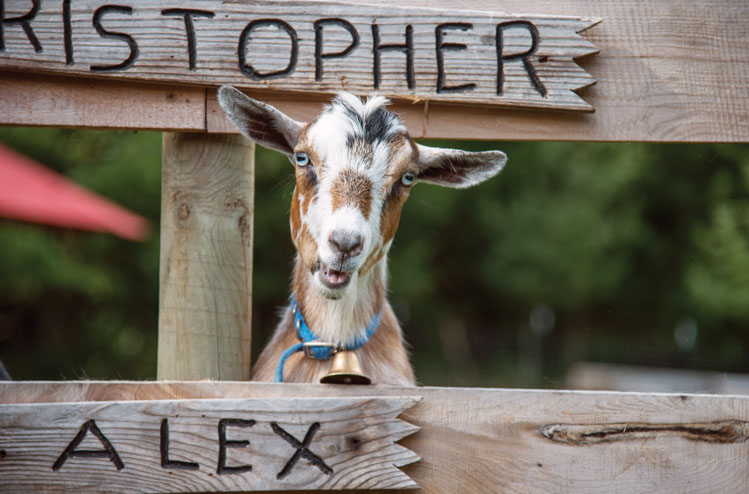 |
| Humans and goats share a deep bond, one that's rich with fun and laughter. Photo by Mark Smither |
When I was growing up in eastern Yankton County, we only knew one person who raised goats — an eccentric bachelor named Ernie Stortvedt, who lived across the road from my grandparents and was famous for his lackadaisical approach to cleanliness. Even in our fun-loving neighborhood, Ernie didn’t set an example anyone was apt to emulate. Goats and Ernie remained linked in my mind for decades.
That changed five years ago, when my niece blew her birthday money on a goat. My family quickly learned that goats are kind of like potato chips — nobody has just one. Soon, my brother and sister-in-law started going to livestock sales in search of goat bargains. Friends offer them goats. Bucks and does regularly escape their sex-segregated pastures and five months later, baby goats arrive. It’s not unusual to find a diapered kid or two in their house, confined in a playpen as they await their next bottle feeding. Now my family describes themselves as goat hoarders. They even have a sweet brown Boer named Honey earmarked for my daughter to work with when she starts 4-H.
Goats will probably never supplant cattle in South Dakota, but ownership is rising. According to the USDA’s National Agricultural Statistics Service, South Dakota’s goat population consisted of 17,868 animals in 2017, an increase of about 7,000 over the previous 10 years. That number will undoubtedly be higher when the next goat census is released in 2022. I asked Katie Freng Doty, Yankton County 4-H’s Youth Development Assistant, if she’d noticed the change. Doty, who raises 30 Boer goats with her husband, Tyler, and daughter, Avery, on their farm north of Mission Hill, said that she and her sister were among the first to show meat goats in our area in 2011. “In my younger years of 4-H I don’t recall there being a Market Meat Goat show at the state fair,” Doty says. “It is now just as big of a show as any of the other species.”
I turned to a few other goat-loving South Dakotans to find out what makes the animals so popular. Most people agreed that goats are livestock on a human scale, which makes sense — archeological evidence indicates that humans first tamed the goat around 10,000 years ago, making it one of the earliest species to become domesticated. Goats also require less space, feed and money than other, larger creatures. But the animals are also intelligent and full of personality, so it’s easy for human and goat to create a deep bond, one that’s often full of laughter. Doty remembers her sister’s first goat, a runt named Bambi. “Any time we would take our goats for walks, her goat would only make it so far and he would just flop over. My sister, who was only 9 at the time, would pick him up and carry him home,” she says. “He caught on to that pretty quick. It didn’t take long and we would only make it a couple steps before he was done walking.”
Four-Legged Hospitality
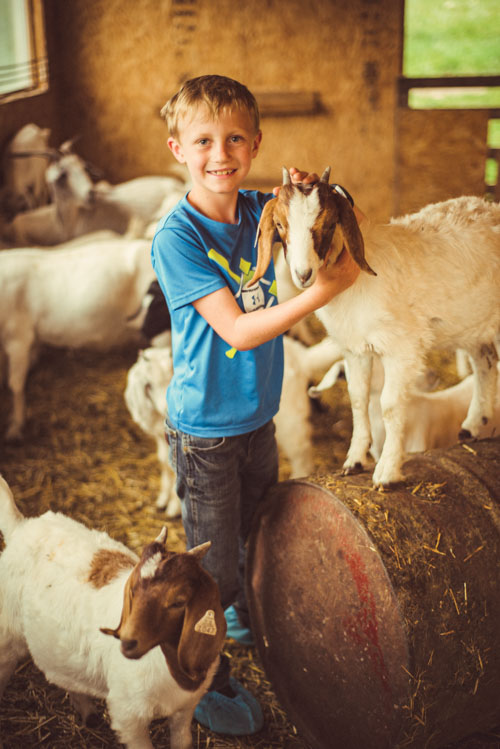 |
| Visitors of all ages enjoy getting to know the livestock at Pleasant Valley Farm and Cabins of Custer. Photo by Ardent Photography. |
In a quiet valley in the southern Black Hills, a guard llama named Batman watches over his herd of goats with a sharp eye and deadly feet, ever on the lookout for mountain lions, coyotes and other threats. “He is not a pet,” says Susan Barnes of Pleasant Valley Farm and Cabins. “We’ve seen him kill coyotes. He stomped them to death.”
Susan worked at the University of Wyoming for decades, while her husband, Tom, was an environmental engineer. But when they retired in 2004, they knew they wanted to return to the 120-acre farm near Custer that Susan’s family had called home for generations. They divided the land into 17 pastures, leaving 40 acres for growing winter feed, and began to raise Boer show goats, but their interests quickly morphed into creating a herd of crossbred Boer, Spanish and Savannah goats for meat purposes. In 2019, the couple opened three vacation cabins and started giving farm tours to Black Hills visitors curious about the goats, Batman, and the rest of the menagerie: two herd dogs, Lily and Monte, a flock of free-range chickens and a few pigs. “A lot of these people are from Chicago and places like that and have never really seen animals,” Susan says. And while the guests may giggle at a goat’s antics and get a kick out of feeding the livestock, Susan makes it clear that farm life is not all fun and games. “You have to be here all the time. It’s dirty. It’s heavy. It can be sad if you have a goat that gets hurt. This kind of work isn’t for everybody.”
Tom, who passed away in August 2020, was a driving force in the promotion of goats as livestock and as food animals in South Dakota — not always an easy task in cattle country. He served as vice president of the South Dakota Specialty Producers for two years, teamed with area chefs to introduce goat meat, also known as chevon, to local palates and was willing to talk goats any time he had a willing listener. “Tom was a good promoter. He really liked people and loved his goats,” Susan says. “He set a pretty good standard for me to keep up. Tom was crazy to get people to buy goats.”
Luckily, Susan has ample support from their two children, who have been heavily involved in business decisions from the beginning. Daughter Molly Schultz and her husband Clayton manage the farm’s social media, Airbnb listing and website, PleasantValleyFarmandCabins.com. Son Tony and his wife Heather live in Alaska, but they helped Tom build the cabins and come home to handle maintenance jobs. “It’s a real family deal,” Susan says.
Susan describes goat meat as healthy, lean and mild. “It’s just kind of unique and it’s not something that overpowers you. I use goat hamburger for everything that I would use regular hamburger for,” she says. The farm supplies meat to A&D Jamaican Restaurant in Rapid City, Wild Spruce Market, Skogen Kitchen and Black Hills Burger & Bun of Custer, which sometimes serves a goatburger special. But their best customers are a group of Pakistani doctors at Monument Health, who use the meat in dishes from their homeland.
Having a local market for meat ensures that the Barnes’ goats are all more or less friendly — a bad attitude is a death sentence at Pleasant Valley Farm. “If you’re mean, you turn into goatburger,” Susan says.
***
New Mexico-Style Green Chili
by Suzanne Stemme of The Goat Rancher
1 pound goat meat, cubed
1 sweet onion, chopped
1 tablespoon oil
1 can black beans
1 can cream-style corn
1/2 cup Hatch green chiles
2 tablespoons ground cumin
1 tablespoon chili powder
Sauté goat and chopped onion in oil until onion is soft (about 5 to 7 minutes). Add black beans, corn, green chiles and spices. Cover pan and simmer on low heat for 1 1/2 hours, stirring frequently. Top with grated cheese and serve with tortilla chips or corn bread.
Soap Making in Smithwick
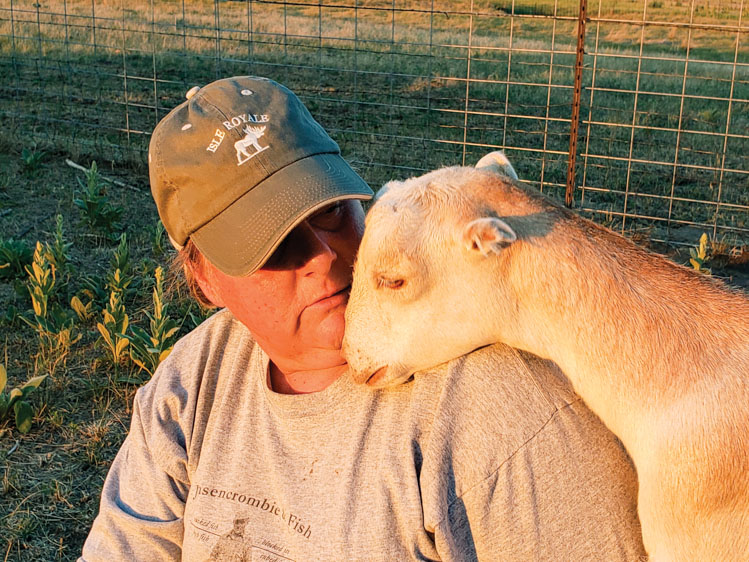 |
| Connie Koski snuggles with Zoey, a small-eared Alpine-LaMancha cross from the High Prairie Dairy Goats herd near Smithwick. |
Anita Mason and Connie Koski, Smithwick’s goat herding soap makers, came to South Dakota for the climate. Mason ran a raw milk cow share program and kept Alpine goats in her native Virginia for decades before she was diagnosed with lupus. Southern humidity exacerbated the inflammatory disease, so the pair moved someplace more arid. “We’re both getting older and we said, ‘If we’re going to do this farming thing, we need to be able to walk,’” Mason says. In 2019, Koski took a job teaching social science at Oglala Lakota College. The two settled in Fall River County and started High Prairie Dairy Goats and the Grubby Goat Soap Company.
Their South Dakota herd primarily consists of LaManchas, a breed with a sweet disposition, high-butterfat milk and nubby, barely-there “gopher ears.” “Everybody always asks about the LaManchas: ‘What happened to their ears?’ They think it’s like docking tails on dogs. You can make lots of jokes,” Koski says. There’s also a rescue Toggenburg who suffered ear loss due to frostbite, but the queen of the herd is a sassy Alpine doe named Lucy. “Lucy’s the boss around here. She’s the only goat with ears,” Koski says.
There are several ways to make soap, but the basic process involves milk, fat and lye, which creates a chemical reaction called saponification. Goggles and heavy-duty gloves are worn to avoid lye burns. “It’s pretty much a cross between a chemistry experiment and a math venture,” Mason says. “Everything has to work out in relation to how much lye you use or you’ll melt your house.” She is not exaggerating — she and her father once tried to wing their way through a batch of soap, with disastrous results. “It ate through an aluminum stockpot we were using, ate through the linoleum, burned through the floor and burned through a rug,” she says.
Mason and Koski make a cold-process soap. First, frozen milk is mixed with lye in an ice-cold bowl. Then coconut oil, safflower oil, shea butter or other fats are gently heated to about 110 to 125 degrees. The milk/lye mixture is slowly combined with the warm oil until it becomes thick. The mixture is then poured into bread loaf pans, allowed to rest for 48 hours, then sliced, wrapped and placed on a shelf. The soap blocks cure for five weeks, which allows excess water to evaporate and eliminates any residual harshness from the lye.
Some soap makers would stop there, but Mason and Koski take an additional step called remilling, in which the blocks of soap are melted in the microwave, along with a small amount of additional milk, fragrance and other additives as desired. The soap is then repoured into molds and allowed to dry for about 24 hours. The remilling creates a soft, smooth soap that is gentle enough for Mason’s sensitive skin. “I like the softer bar,” she says. “If I’m comfortable, then everybody else should be comfortable.”
The pandemic halted craft shows, so goat’s milk soap production has slowed accordingly. Instead, the pair focuses on raising milk-fed pork. “It really makes a difference in the meat. It’s a super moist pork,” Mason says. “It tends to be very flavorful, like somebody slow-cooked it for two days.”
Once the pandemic ends, Koski hopes to introduce South Dakotans to their docile LaManchas. “Our plan was to bring some of these awesome East Coast lines out this way. It’s hard to go meet the kids at 4-H because COVID put the kibosh on that. Maybe we aren’t super awesome yet, but we’d really like to start showing,” she says. Mason wants to educate people about the value of dairy goats as part of a self-sustaining lifestyle. “There’s just no better animal than a dairy goat for that. You can make your own dairy products. You can raise bum lambs and calves off of their milk. Most people could have one in their backyard.” But perhaps their greatest challenge is finding a trusted neighbor so they can take a vacation. “We’re trying to sucker somebody into looking after the goats so we can get away for a while. It’s not working out very well for us. As soon as we say ‘dairy goats’ they run,” Mason says.
Raised by Goats in Groton
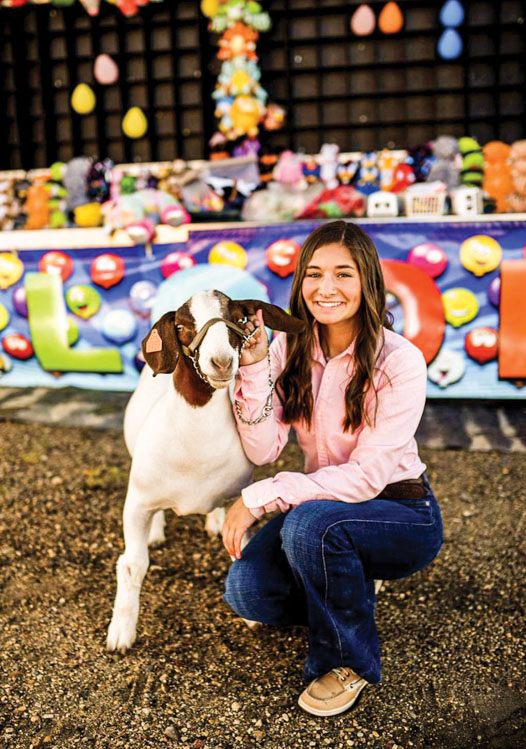 |
| Tessa Erdmann of Groton had learned patience and adaptability through her work in the show ring. Photo by Jacee J Photography. |
After his family sold off their herd of registered Angus cattle, third-generation farmer Darrin Erdmann of Groton vowed to stick to corn and soybeans. Then his daughter, Tessa, joined 4-H. Erdmann bought her three goats, two does and a wether, and it all went downhill from there. “You can’t keep a waterer open for just three, so I got about 15 more. Then you can’t pay for the water with just 15 so I got about 20 more. Then we bought some more. At one point we had about 150,” Darrin says. “A project like this is hard to run as a business. It turns into a hobby, so you’re not really watching your balance sheet on it.”
The Erdmann family, which includes wife Julie and son Jarrett, raises predominantly Boer-based show goats, supplying animals to 4-H kids and to the local population of Karen and Somali immigrants. Darrin also owns Texkota Panel and Gate, distributing durable American-made steel pens to livestock producers.
Darrin remembers the public’s puzzlement when his daughter first showed goats at the South Dakota State Fair. “These old farmers would walk through and they were just amazed. ‘Why do we have goats here? This is South Dakota.’” But as a member of the state’s 4-H meat goat committee, Darrin has seen firsthand the goat explosion, which he credits in part to the bond that children develop with their animals. “Every one of them has almost a pet quality. Other livestock do not get that bond with a kid,” he says.
Tessa, a senior at Groton High School, has had the opportunity to bond with many goats since she first started showing in 2013 — some more successfully than others. Her first year, she wrangled a 100-pound hellion named Thunderbolt. “He had the worst personality. He was just absolutely wild. Holding that goat was never easy,” Tessa says. But she didn’t give up. “It drove me to try new things, different coolers, different feed, sit in their pen a little bit more. The next year, all the changes that I made paid off.”
That adaptability has served Tessa well, both when it comes to bonding with goats and when dealing with surprises in the show ring. One of her most harrowing experiences happened when her goat got diarrhea in front of a first-time judge in the middle of the 2018 Senior Showmanship competition. “I didn’t know what to do because obviously that’s not good looking for a show animal,” she says. “I wiped it off on my hand and wiped it on the side of my leg and kept going. That was probably the most disgusting thing I’ve ever done.” The judge never mentioned the mishap, and Tessa and her goat won the competition.
But whether Tessa won or lost, perhaps one of the greatest gifts Tessa has gotten from the goat world is friendship. “When I would go to these shows, all the kids there were just like me. They worked with their livestock day in and day out. They’ve become like a second family,” she says. Tessa is deciding whether to attend South Dakota State University or Oklahoma State University, but wherever she goes, she knows that friendly faces will make college feel like home. “4-H and FFA have given me the opportunity to branch out and meet so many different people,” she says. “My friends always joke if they meet a new person I probably know them first.”
Tessa gives 4-H a lot of credit in shaping her into the confident young woman she is today, but her father puts it more bluntly. “People always say, ‘Tessa’s such a good kid. Who raised her? It wasn’t you.’ It was the goats.”
From Finance to Fromage
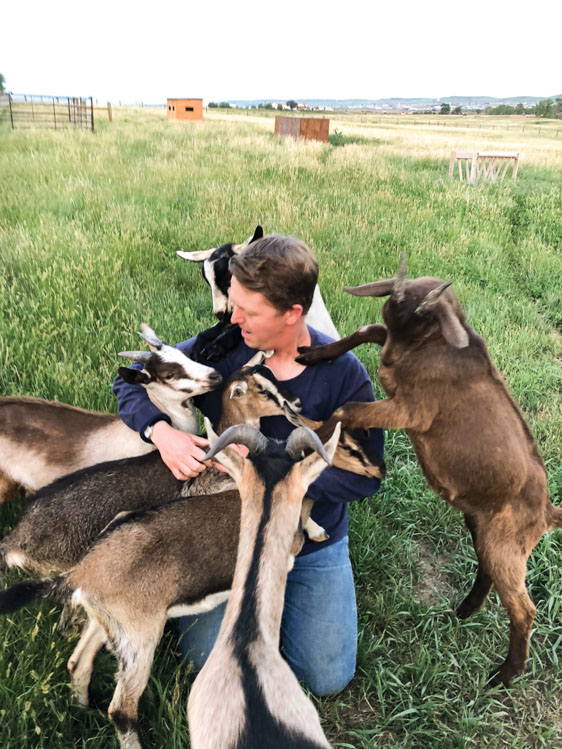 |
| Rapid City cheesemaker Spencer Crawford believes dairy goats are a good addition to a self-sufficient homestead. |
Spencer Crawford went overseas to study finance and came home a goat farmer. After attending graduate school in Paris, he found himself drawn to socially and environmentally responsible entrepreneurship. During the course of his 10-year stay in France, he raised bees outside of Paris, dabbled in permaculture and was considering a move to West Africa to raise goats when a phone call from his mother changed everything. “My mom says, ‘No, no, no. I can visit you in Paris, but I don’t think I can make it to West Africa. Why don’t you come home? Why are you going to be a farmer in Africa? You can be a farmer in Pennington County,’” Crawford remembers. “Listen to Mom. Usually she’s right.”
Crawford returned to his native Rapid City three years ago, where he teaches French and Spanish at St. Thomas More Middle School and practices small-scale agriculture on his parents’ acreage north of town. His father, Tony, watches the farm during the day. “He helps out, but he and his friends are still scratching their heads. He never thought that his horse barn would be filled with a bunch of goats. I think the horses might be a little confused too,” Crawford says.
Some cowboys mock goats as “the poor man’s cow,” but Crawford appreciates the animal. “In terms of what they eat and what they produce, it’s just a lot more human scale,” he says. “You don’t need a ton of land, a ton of infrastructure. To milk the goats, you need a bucket with a lid, and the home kitchen is enough to have your family totally self-sufficient with milk and cheese and soap.”
With his herd of 10 Alpine dairy goats, plus chickens, honeybees and a number of cats, Crawford engages in permaculture, an interconnected style of farming in which all of the elements work together holistically. “Every plant that you plant, you can eat it or the goats can eat it,” he says. “No loafers. Everyone has a job.” One of the goats’ jobs is to provide rich milk, which Crawford uses to create tomme, an aged, washed-rind cheese.
The origins of cheesemaking are lost to time, but it is believed that the first cheeses were made when fresh milk was stored in pouches made from animal stomachs. Rennet, a mixture of enzymes found in the stomach’s lining, coagulated the milk and caused curds and whey to form. Crawford’s method is a bit more sophisticated. First, goat milk is heated in a sterilized pot. Next, bacteria is added to help the cheese develop flavor, followed by the curd-forming rennet. The curds are separated from the whey, placed in a mold or cheesecloth, weighted down and salted. This helps remove moisture from the cheese and encourages a crust to form. “It’s going to look a little spooky sometimes, but what’s inside is the good stuff,” Crawford says. His cheeses are left to age in a spare refrigerator in his basement. Cheese ages best in a humid environment at a temperature of about 50 degrees, so Crawford stores the cheeses in Tupperware containers with the lids cracked open and periodically washes each cheese with salt water. This helps kill bad bacteria or mold, develops the cheese’s protective crust and draws out additional moisture.
Unlike a commercial operation, there are many variables involved in Crawford’s cheese, so every wheel is a surprise. “The cheese is kind of a living, changing entity of its own,” he says. “You cut into a cheese that you’ve been saving for 10 months and then the wheel of cheese next to it that you made three days later and you think, ‘What the heck? Why is this one so delicious?’”
Crawford would like to build a commercial kitchen, but due to government regulations, a health department-compliant cheesemaking facility is an expensive proposition. For now, he’s content to watch the comic interactions between his animals, share his best cheeses at potlucks and enjoy his after-school farm venture. “Some people go to the bar after work. I go milk some goats,” he says.
Editor’s Note: This story is revised from the March/April 2021 issue of South Dakota Magazine. To order a copy or to subscribe, call (800) 456-5117.










Comments